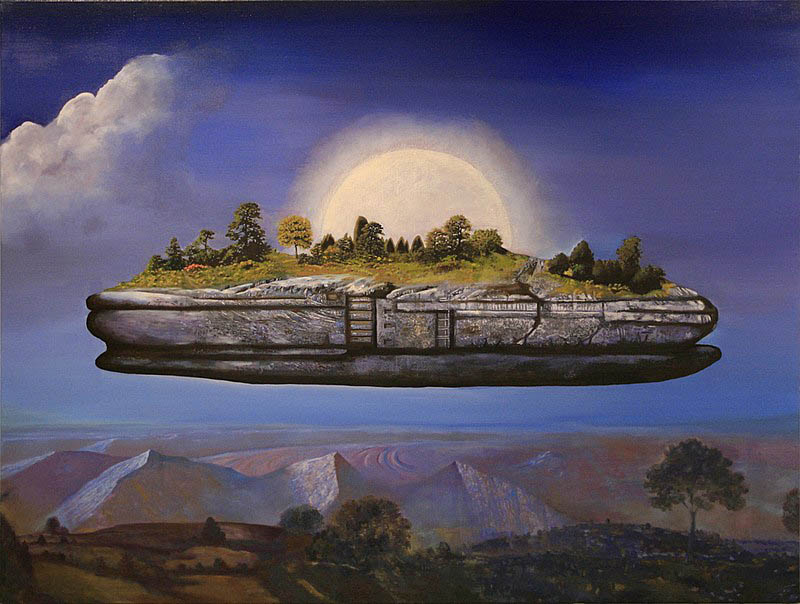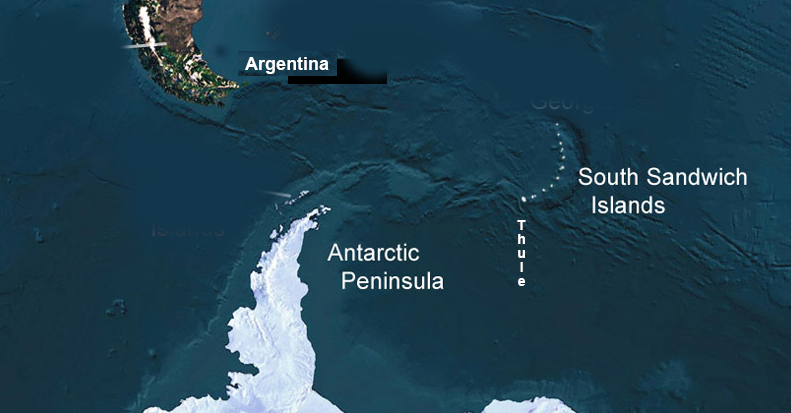

In this depiction, the City of the Caesars looks like a UFO which can also be said of other ancient submerged mythical cities. Patagonia is not far from Antarctica and its underground mysteries which includes UFOs (USOs), and subterranean cities that allegedly still exist.

The City of the Caesars, also variously known as City of Patagonia, the Wandering City, Trapalanda or Trapananda, Lin Lin or Elelin, is a mythical city of South America. It was supposedly located somewhere in Patagonia, in a valley of the Andes between Chile and Argentina. Despite being searched for during the colonization of South America, no evidence proves that it ever existed, although reports of it circulated for two hundred years.
In 1766 a Jesuit, Father Jose Garcia Alsue, explored the area now part of Queulat National Park in Aysen Region, Chile, searching unsuccessfully for the City of the Caesars.
The city is described as prosperous and rich, plenty of gold, silver and diamonds. At least one description says it was located in between two mountains, somewhere in the Andes mountains, one of gold and another of diamonds.
Sometimes it is described as an enchanted city that appears in certain moments; or such that those who come upon it by chance in their travels forget the encounter; or such that hunters of it will walk away with mountains of fortune and treasure.
Its purported founders include survivors of a Spanish shipwreck in the Strait of Magellan, survivors in exile of the Destruction of the Seven Cities, ghosts, Patagonian giants and survivors of the Inca Empire; indeed, one explanation of the legend is that it derived from stories told to sailors by aborigines describing the Empire of Peru.
City Of The Caesars: Legend Speaks Of A Fantastical City In Patagonia
IFL Science- March 29, 2023
Was it the dreamt nonsense of conquistadors or were they onto something?
Legend has it that the rugged land of Patagonia in the southernmost strip of the Americas is home to a long-lost kingdom known as the City of the Caesars. Like many of the tales of mysterious ancient cities in the Americas, there's no substantial evidence this place ever existed. With that said, new imaging technology is continuing to reveal traces of hidden ruins throughout the Americas and showing that dreams of forgotten cities aren't perhaps as fanciful as once thought.
When South America was being colonized by the Spanish and Portuguese, rumors of this city spread far and wide. As with the many stories of South America's fantastical cities that arose at the time, like El Dorado or the Lost City of Z, conquistadors were eager to locate the civilization as it was said to be home to immense wealth, laden with gold, silver, and diamonds.
It's unclear where this rumor started. The myth of the City of Caesars is sometimes credited to Sebastian Cabot, a Venetian explorer who traveled to South America, although other prominent explorers of this time, such as Sir Walter Raleigh, are also said to have been early believers.
One account says the city was founded by Spanish sailors who became shipwrecked along the ragged Patagonian coast, while another fanciful origin story suggests it was founded by elite Romans who fled amid the chaos after the assassination of Julius Caesar.
One of the most notable attempts to find the city was Father José García Alsue, a Jesuit missionary who explored the modern-day Aysen Region of Chile in 1766. While accounts of his journey are scarce, it's safe to say it ended in failure.
Just like Atlantis, it looks like the City of the Caesars is little more than a tall tale, fueled by misunderstanding and miscommunication.
Nevertheless, a number of recent technological developments are starting to challenge old assumptions about pre-Colombian cultures and suggest that South America was filled with significant settlements before the Europeans arrived.
One of the most important tools is LiDAR, a remote sensing method that uses light in the form of a pulsed laser. By surveying large amounts of land from a helicopter or plane, LiDAR imagining is able to peer through the dense rainforest overgrowth to reveal traces of human-made ruins that lay beneath.
As just one example, this technology has been used by archaeologists to discover ruins of a sprawling ancient Maya metropolis hiding in northern Guatemala, which once consisted of 60,000 houses, palaces, defensive walls, causeways, and highways.
Other discoveries include a colossal monumental platform in Mexico measuring 1,413 meters (4,635 feet) north to south and just under 400 meters (1,312 feet) east to west.
None of this is to say the City of the Caesars is real, nor that its ruins may still be out there hiding in the depths of Patagonia. However, it does hint that the southern stretches of the Americas are home to numerous cities that have since been lost to time. Perhaps the first Europeans who set foot in this land, amid ignorance and bewilderment, mistook these ruins for the long-lost remains of a mystical city. '
Chile Connections to Antarctica's Underground Bases
Antarctica - The Hologram Project - Project Highjump - Aliens
The Narrative: Antarctica, South Sandwich Islands, Constellations
La Palma Canary Islands Mega-Tsunami Theory